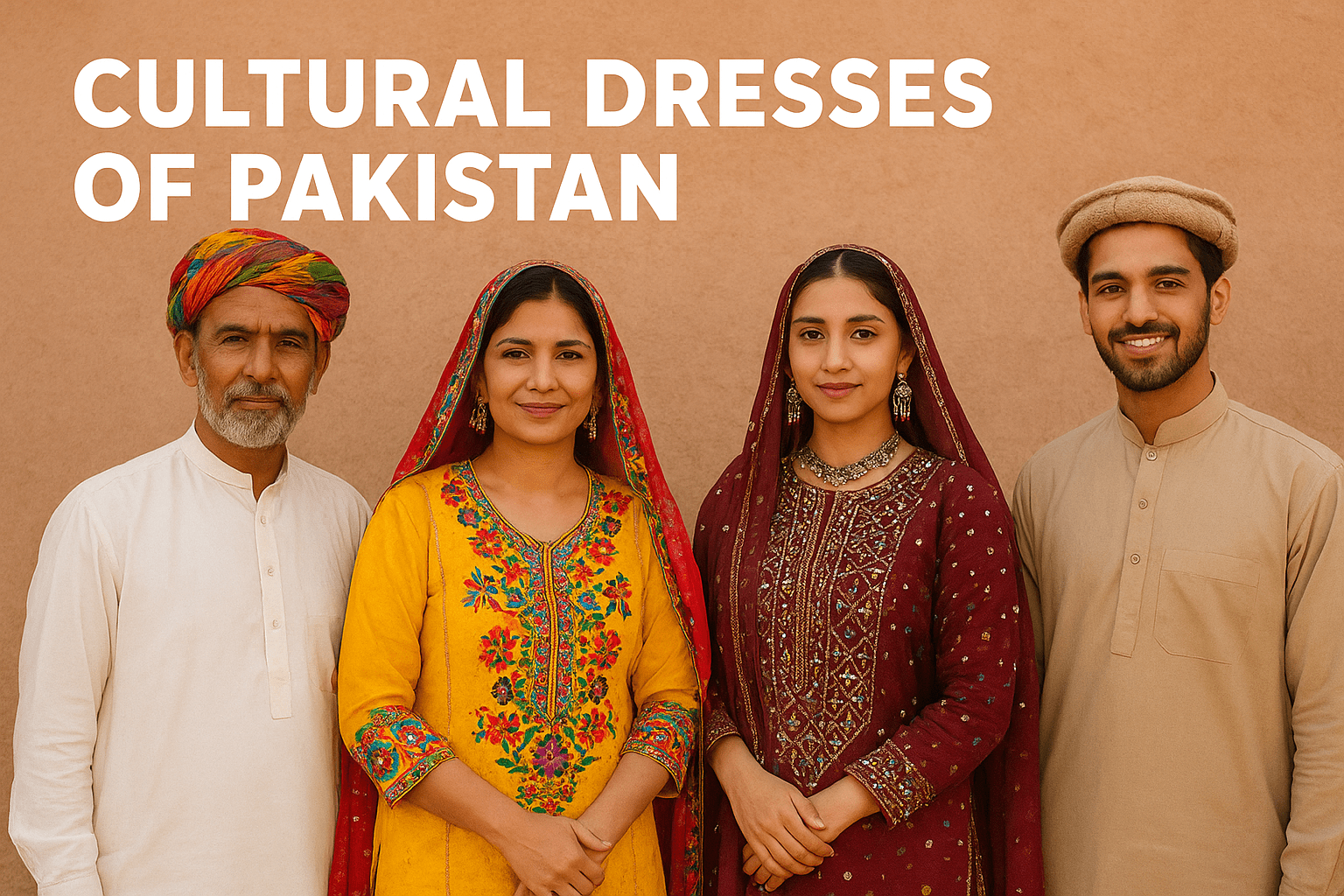Pakistan is a arrive of breathtaking social differing qualities, where each locale tells its story through nourishment, celebrations, language—and most conspicuously, conventional clothing. The social dresses of Pakistan (Primary Keyword) delightfully reflect its history, climate, craftsmanship, tribal personality, and centuries-old aesthetic legacy. From the weaved tastefulness of Sindh (NLP Entity) to the dynamic strings of Punjab (NLP Entity), the reflect work of Balochistan (NLP Entity), and the woolen beauty of Gilgit-Baltistan (NLP Entity), Pakistani clothing, ethnic wear, and traditional attire are a living expression of both convention and present day identity.
This web journal investigates the wealthy embroidered artwork of Pakistan’s social clothing, counting territorial dresses, textures, weaving styles, and the chronicled impacts that molded them. Learn more about Pakistan’s textile history through UNESCO’s heritage listings at UNESCO Intangible Cultural Heritage
Significance of Social Clothing in Pakistan
Pakistani social dresses are more than garments—they speak to personality, nobility, craftsmanship, and celebration. Whether worn amid weddings, Eids, Urs celebrations, territorial fairs, or day by day life, these dresses reflect:
- Ethnic background
- Climate and geography
- Local craftsmanship (Ajrak, Phulkari, Khes, Pashmina)
- Religious and verifiable influences
National Dress of Pakistan – The Ageless Shalwar Kameez
Shalwar Kameez stands gladly as the national dress of Pakistan (Primary & Focus Keyword), worn by men, ladies, and children over all areas. Its flexibility and consolation make it perfect for Pakistan’s differing climate.
Why Shalwar Kameez is Generally Loved
- Available in cotton, grass, khaddar, chiffon, silk & linen
- Adaptable for casual, merry, and formal wear
- Embellished with weavings like zari, dabka, and threadwork
- Represents solidarity over territorial diversity
Social Dresses of Pakistan by Region
Each locale of Pakistan has protected its unmistakable clothing legacy. Here’s a nitty gritty look:
Punjabi Social Dress – Dynamic, Folk-inspired & Expressive
Punjab’s clothing is known for its colorful and striking plans that reflect warmth, celebration, and agrarian life.
Men’s Conventional Wear
- Kurta & Tehmat (Lungi)
- Khaddar Kurta in Winters
- Turban (Pagri) symbolizing pride and status
Women’s Conventional Wear
- Shalwar Kameez with Phulkari Dupatta
- Gharara or Sharara amid weddings
- Bright colors with overwhelming threadwork
Sindhi Social Dress – Wealthy Weaving, Ajrak & Reflect Work
Sindh is celebrated around the world for its Ajrak—a centuries-old block-printed shawl symbolizing adore, regard, and Sindhi identity. Explore Ajrak history.
Men’s Sindhi Dress
- White Shalwar Kameez combined with
- Ajrak and Sindhi Topi (cap with reflect designs)
Women’s Sindhi Dress
- Ghagra Choli or weaved kameez
- Heavy reflect work (Shisha)
- Geometric and botanical threadwork
Balochi Social Dress – Tribal Pride, Overwhelming Weaving & Interesting Cuts
Balochi clothing speaks to centuries of tribal legacy and craftsmanship.
Men’s Balochi Dress
- Loose Shalwar Kameez
- A long turban (Pug)
- Traditionally more extensive and heavier trousers
Women’s Balochi Dress
- Heavily weaved Balochi dress (Jama)
- Kundan, beadwork, Dabka motives
- Mirror work around sleeves and neckline
Pashtun Social Dress – Humble, Agile & Mountain-Inspired
Influenced by mountain climates and Afghan legacy, Pashtun dresses are exquisite and functional.
Men’s Pashtun Dress
- Perahan Tunban
- Chitrali Cap / Pakol
- Woolen shawls in winter
Women’s Pashtun Dress
- Bright, streaming frocks
- Handcrafted beadwork and metallic embroidery
- Heavy jewelry: headpieces, bangles, midsection belts
Gilgit-Baltistan Social Dress – Woolen, Warm & Mountain Crafted
Gilgit-Baltistan (GB) lies in the cold northern locales of Pakistan, affecting its attire.
Men’s Dress
- Woolen Shalwar Kameez
- Traditional GB Cap (Jinnah Cap)
- Shawls made from yak wool
Women’s Dress
- Long weaved gowns
- Irshad caps enhanced with feathers
- Pashmina shawls
Kashmiri Social Dress – Pheran, Delicate Textures & Patterns
Kashmiri dress is synonymous with Pheran, a free woolen robe worn in winter.
Key Clothing Elements
- Kashmiri Pheran
- Kashida embroidery
- Soft shawls made of fleece, pashmina, or rabbit hair
Bridal Social Dresses in Pakistan
Bridal clothing in Pakistan shifts territorially but is ordinarily luxurious, intensely weaved, and typically rich.
Types of Bridal Dresses
- Lehenga
- Sharara / Gharara
- Maxi or pishwas
- Traditional red outfit with gold dabka work
Conventional Textures & Make Methods of Pakistan
The country’s material legacy incorporates a few world-famous crafts:
Key Traditional Crafts
- Ajrak block printing
- Phulkari embroidery
- Rilli patchwork
- Khes weaving
- Hand-knotted carpets
- Pashmina weaving
These makes bolster thousands of neighborhood artisans and protect social identity.
Impact of Advanced Design on Pakistani Social Clothing
Despite modernization, social dresses stay profoundly esteemed. Today’s creators blend:
- Traditional embroidery + advanced cuts
- Cultural themes + modern fabrics
- Regional character + worldwide trends
Why Social Dresses Matter in Advanced Pakistan
Cultural clothing strengthens:
- National identity
- Craft preservation
- Tourism through cultural festivals
- Economic improvement for artisans
Cultural clothing remains a image of pride for millions of Pakistanis worldwide.
Conclusion
The social dresses of Pakistan offer a striking see into the country’s dynamic personality. Each locale tells a interesting story through clothes—whether it’s Sindhi Ajrak, Balochi embroidery, Kashmiri Pheran, or Punjabi Phulkari. In spite of present day design impacts, conventional clothing remains cherished, celebrated, and gladly worn over eras. This wealthy differences makes Pakistan one of the most socially expressive countries in the world.
For reading more blogs like this visit mmtravelspk.com .

